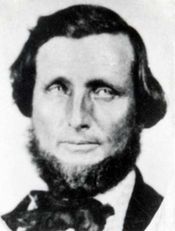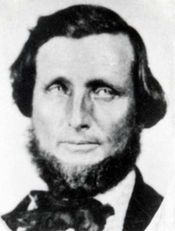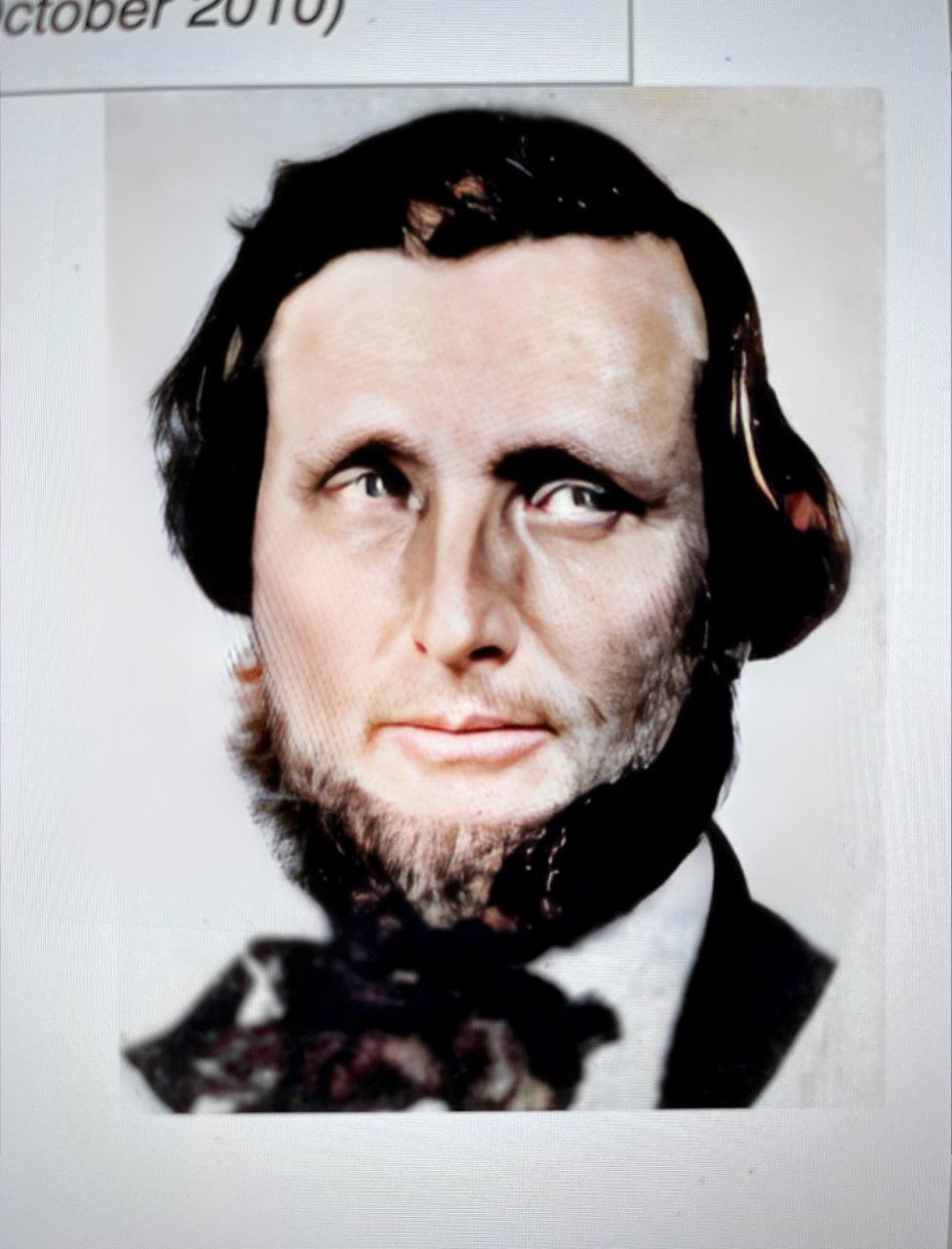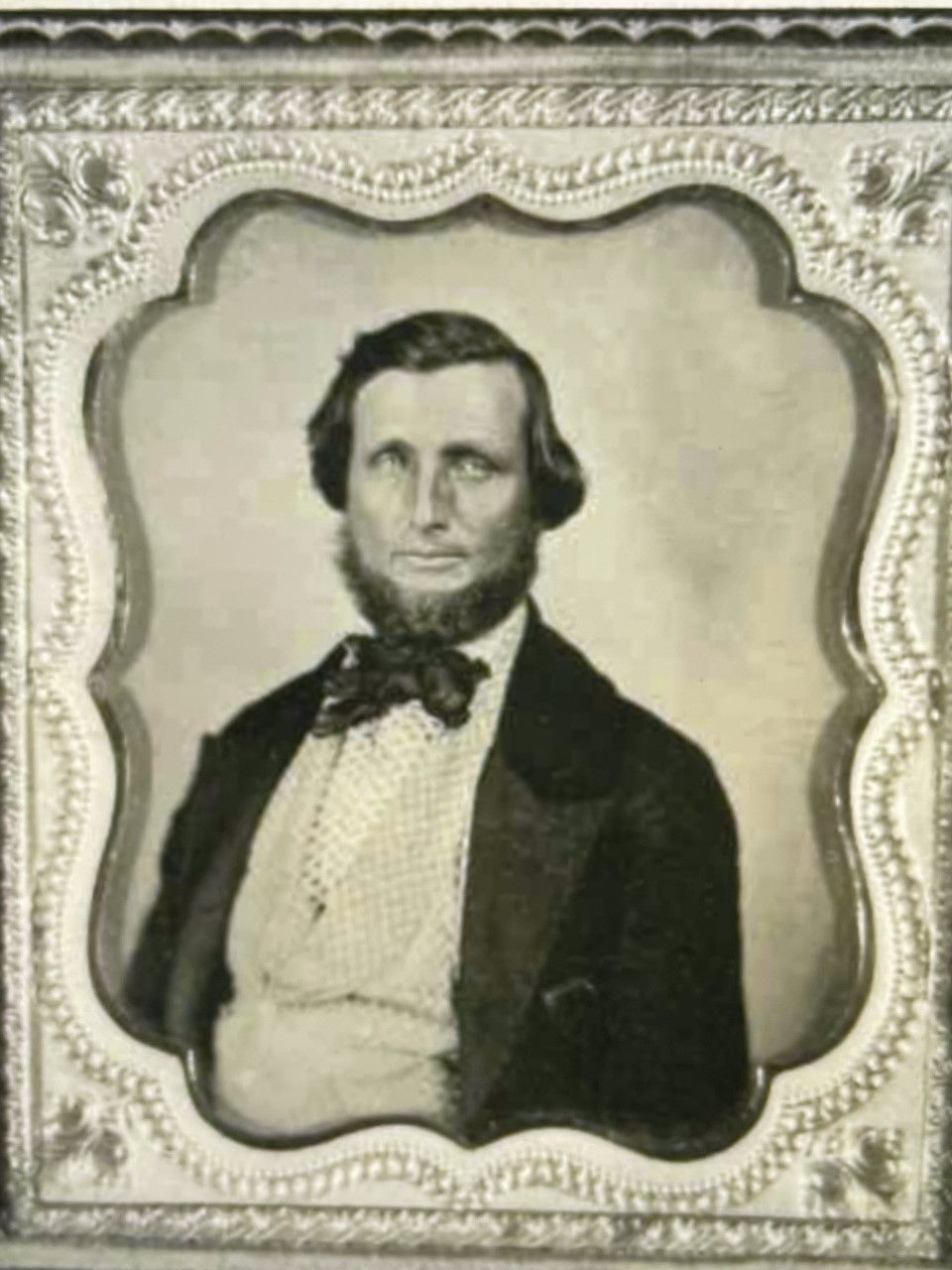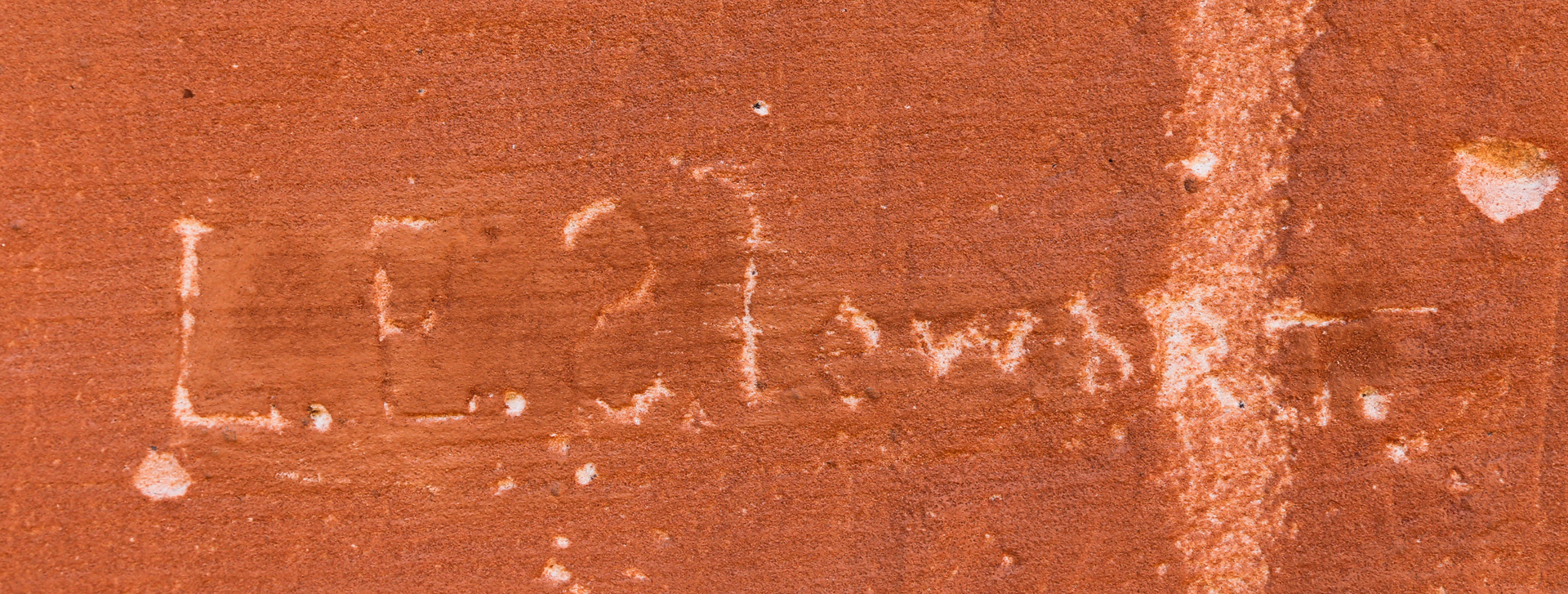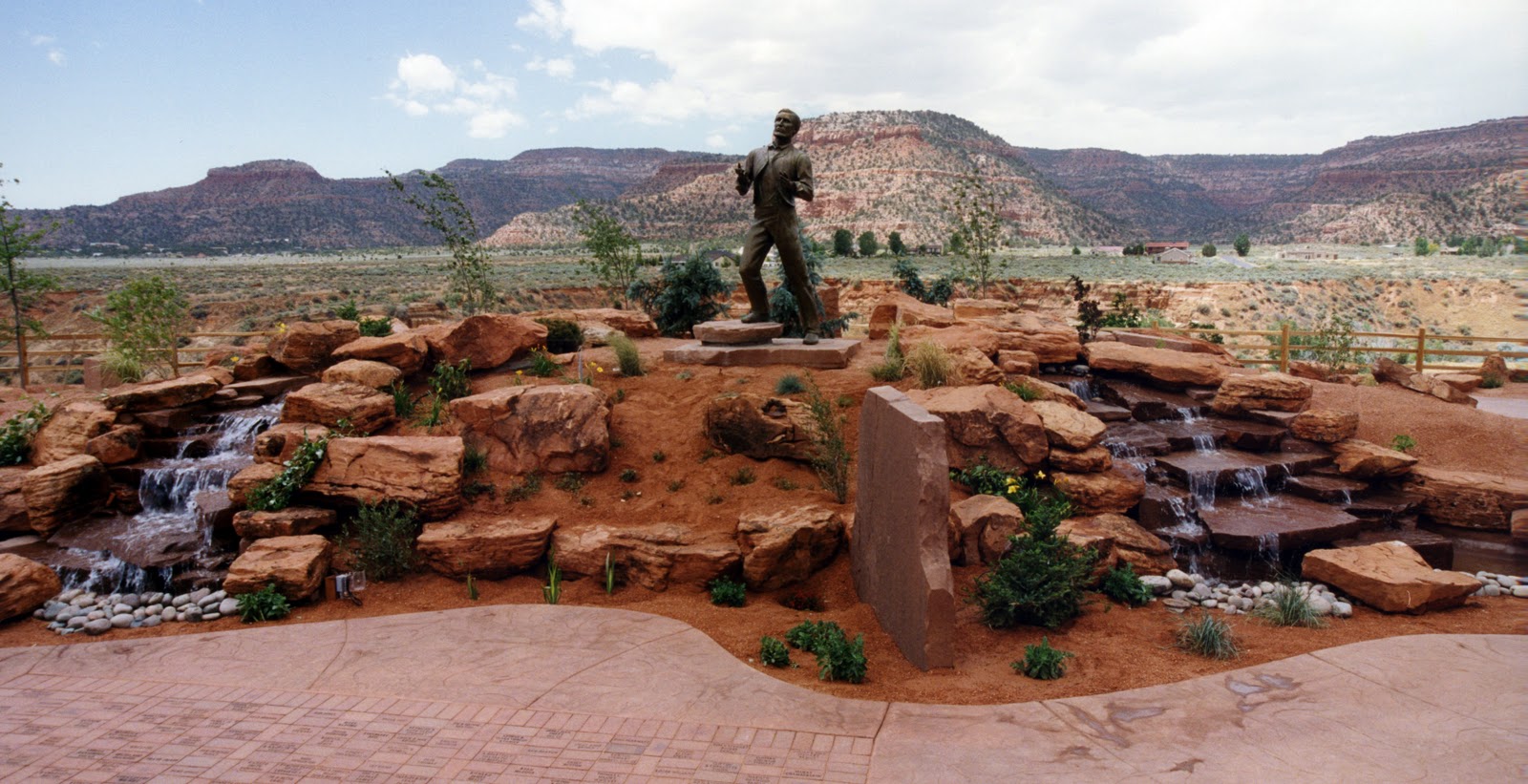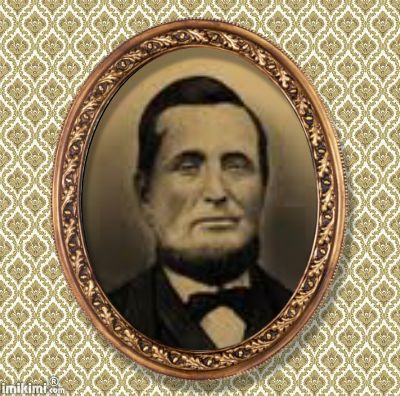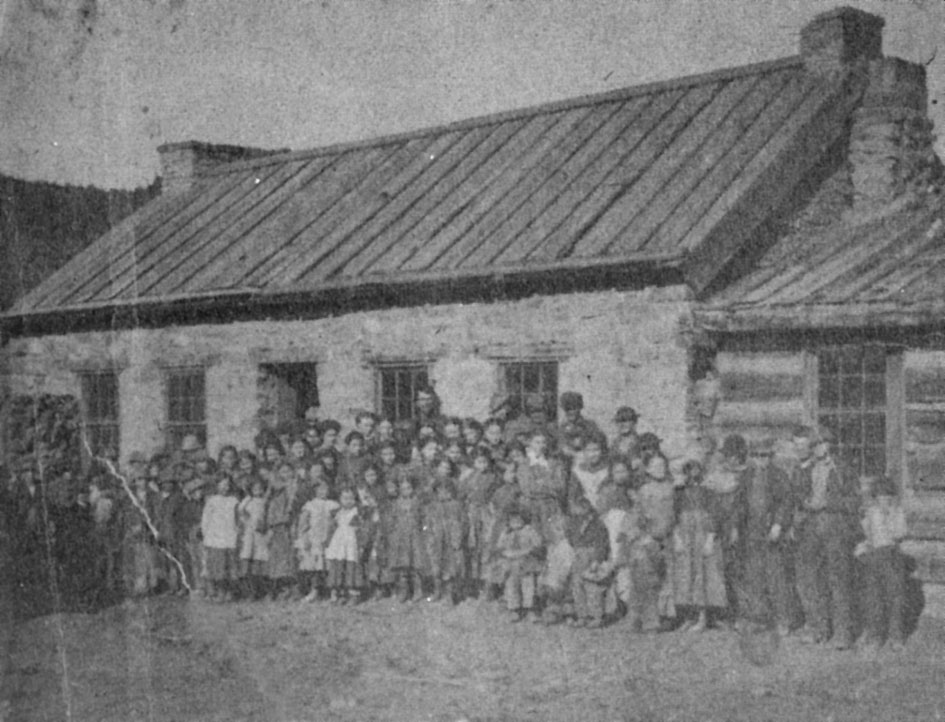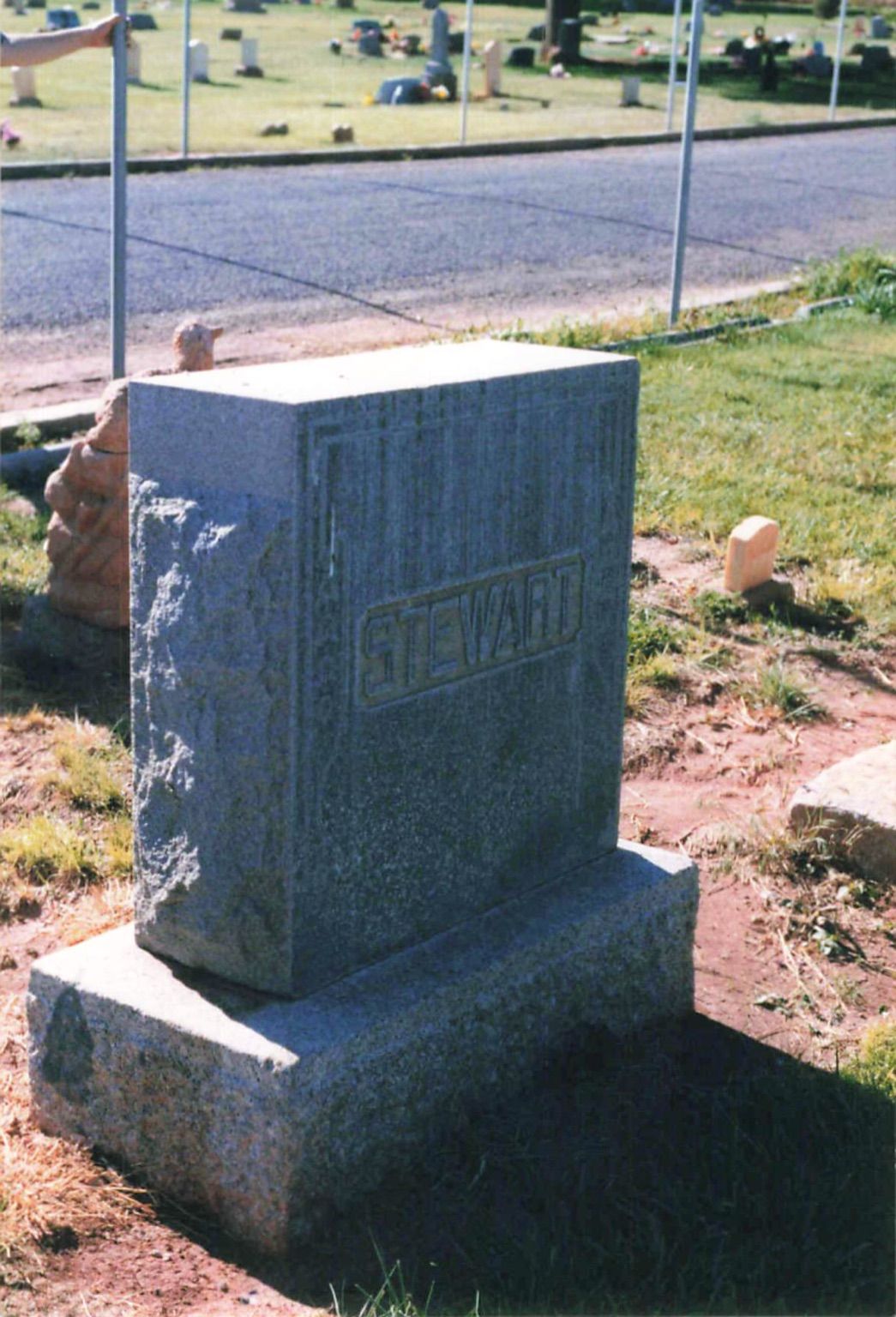Son of William Stewart and Elizabeth Van Hooser
Married Melinda Howard, 7 Feb 1833, Madison County, Illinois
Married Charity Holdaway, 13 Jan 1846, Nauvoo, Hancock, Illinois
Married Margery Wilkerson, 13 Dec 1852, Salt Lake City, Salt Lake, Utah
Married Artemacy Wilkerson, 23 Dec 1854, Salt Lake City, Salt Lake, Utah
Married Susan Elizabeth Eager, Sep 1874
History - Levi's ancestors had come to America in earliest colonial times from Scotland, where they formed part of that clan of sturdy Highlanders who boast the Stewart line of kings of Scotland and England. The first Stewart of Scotland married Margery, the daughter of Robert Bruce, and founded the royal line. Many of the Stewarts were Scottish Covenanters and as such were banished to Ireland from where they soon made their way to America, settling in Pennsylvania, New York, and Virginia.
At the time of the Puritan Revolution, those of the Stewarts who had chosen to unite their fortunes with those of the royal family in England were forced to leave England and find haven in the New World. From those who settled in North Carolina came the direct ancestors of Levi Stewart, who, humbled by the turn fate had given them, became thrifty, hardworking members of the working class. They eventually moved westward into Tennessee and some went northward into Virginia. The noted Confederate general, J. E. B. Stewart, was of this line. From Overton County, Tennessee, Levi's father, William, moved northward. In Indiana he married the charming Hooser maiden, Elizabeth Van Hooser, then they moved to Illinois, on the banks of the Mississippi, where their four sons were born.
The only childhood incident in Levi's life that is known to be but a forerunner of his life of struggle with frontier conditions was when he was about nine years old. Levi and his brother Jackson, just younger, were picking up pebbles along the riverbank and putting them in their held-up aprons, the ridiculous sack-like dress worn by little boys of that section at the time. As they rounded a curve, they came face to face with a cinnamon bear that, to them at least, seemed enormous. It reared up on its hind legs and began to growl and start toward them. They threw stone after stone as hard and as fast as they could, but seemed to make no impression whatsoever, until Levi, in desperation, aimed carefully and hit the beast squarely on the nose, hurting it enough that it turned and made off into the timber.
Levi's mother was at this time a widow with four boys: Riley, Levi, Jackson, and Urban. (One son, Squire, had died in infancy.)
In 1830 when Levi was only eighteen, he married his second cousin, Malinda Howard. Their first child, Jane, was born a year later. Life was almost primitive; only the bare necessities reached the settlers up the Mississippi by way of small boats. They exchanged hides, tallow, furs, and products of their own handicraft for axes, hatchets, cards for carding wool and cotton, spinning wheels, guns, and powder. It was considered a disgrace for a young woman not to know how to take raw flax, cotton, or wool through the whole process of manufacture from carding, spinning, dyeing, weaving, and sewing into well-made garments. Malinda was the typical thrifty housewife, even at an early age.
In 1836 two Mormon elders, Durphy and Peter Dunstan, stayed a few days with Hanford Stewart, a cousin of Levi, and they preached in the neighborhood. A year later, an Elder King preached from many of the nearby homes and excitement over the gospel became quite general.
Levi Stewart, who was then living at Luck Creek, Illinois, became interested, and in about 1837, he went to Far West, Missouri, to investigate this wonderful new religion at its headquarters. He was convinced of its truth and joined The Church of Jesus Christ of Latter-day Saints there. When he returned home, he brought the Book of Mormon and copies of the Elders' Journal to show and explain to his neighbors.
In the diary of one of those neighbors were found the following words: "My neighbor Stewart, who had just returned from Missouri, brought the most cheering and thrilling accounts of the power and manifestation of the Holy Spirit working with the people: that the spiritual gifts of the true believers in Christ were enjoyed by all who lived faithfully and sought them; that there was no deception about it; that everybody had a testimony for himself and was not dependent upon another; that they had the gift of tongues and the interpretation of them, the power of healing the sick by the laying on of hands, prophesying, and casting out devils. All of which he declared, with words of soberness, to be true.
"Levi Stewart had been my playmate and companion in former years. His word had great influence on me and strengthened my conviction that the Book of Mormon is true."
There are no further records of these first contacts made by Levi, but it is known that he was deeply filled with a testimony of the gospel which was to be his guide throughout his life.
Levi and his family had decided to join the Saints in Missouri and to cast their fortune with them no matter what sacrifices they were called upon to make. They sold their home and possessions in Luck Creek, and on June 4, 1838, they arrived in Far West and settled on Shady Grove Creek in Davies County at a place that would later be called Ambrosia. Levi's brothers Riley, Jackson, and Urban lived nearby, and their mother lived with one of them. For fifteen or twenty miles around them in each direction, the country was settled by Saints.
The location of the Stewart home was a good one, for it had plenty of pure, cold water. A small lake nearby was filled with many kinds of fish, so there was an abundance to fill their needs. There were groves of oak and hickory on the rolling land, and before many months, a comfortable home was established.
In July, 1838, Levi visited the settlement of Adam-ondi-Ahman and remained overnight at the home of Judge Morin, an active Democrat. The judge told him that at the coming election, the Whigs were planning to prevent the Mormons from voting at the county seat. He advised the Mormons to go to the polls prepared to resist violence in order to vote as free Americans.
When election day arrived and the Mormon men were awaiting their turn to vote, a bully by the name of Weldon started calling one of the men vile names because he was a Mormon. When he said that Joseph Smith was a liar, Riley Stewart could stand it no longer, and he gave Weldon a stunning blow. The fight then became general as the Mormons tried to save Riley from the mob that sprang up as if by magic. He was stabbed in the shoulder and severely battered, but he managed to escape to the home of a brother-in-law. As long as he stayed in Missouri, the mobs sought his life.
When the Prophet and the leading authorities of the Church gave themselves up to the state militia in an attempt to save the people from massacre, the rest of the male Church members were held as prisoners at Far West to be tried for treason. Levi Stewart was among those who were forced to march double file and surrender themselves and their arms. Each man was made to sign a treaty giving all his real estate and property to the state. Then the men were locked in schoolhouses for much of the time.
General Wilson was in charge of five hundred troops who were sent to force the signing of the treaty on Adam-ondi-Ahman, as they had done in Far West. Levi was one of three men selected to accompany the troops as a guide. Before they reached that community, some officers who had taken a liking to their guides released them to return to their families in Far West. It was a time of rejoicing for the men's families, who had feared for the lives of their husbands and fathers.
Upon the advice of the father of Joseph Smith, Levi and his family traveled to Fayette County, Illinois, in February, 1839, to meet a group of the Saints there. Upon crossing the Mississippi River at Quincy, they located the area in which many Mormons had camped. After making arrangements for the comfort of his family, Levi left on a mission with John D. Lee in April of 1839, returning back to his family in October of that year.
In the middle of April, 1840, the Stewarts joined the Saints who were gathering at Nauvoo. The Prophet was out of prison by then, and work was soon started on the temple. Levi gave one out of every ten days to work on the temple.
In Nauvoo, Levi built a comfortable home and his family experienced several eventful years there. Levi was impressed by his association with the Prophet and his attendance at the School of the Prophets, where he developed a love for learning and culture that meant so much to him in his later pioneer days. He was a member of the Nauvoo Legion and was always proud of the uniform and sword that attested to his membership.
Again Levi was called on a mission to go to several nearby states with his brother Urban. They were called home, however, because of the death of their mother. Again they went forth, only to be called back once again, this time because of the assassination of the Prophet.
From that time, their lives in Nauvoo were anything but peaceful. They were left defenseless against their enemies, and were harassed constantly by the infuriated mobs. Finally, the Saints were driven out of their homes, and the Stewarts were among those whose crops were burned; their home was taken over by a ruffian who threw a pair of suspenders at Levi, then declared that the home was his since he had paid for the place.
The Saints were prepared for this eventuality. They had worked unceasingly at the manufacture of wagons, harnesses, and other articles needed for a journey. Trees had been cut, and the lumber was boiled in salt water or dried in kilns to cure it quickly and toughen it. Leather had been tanned; iron was hand-wrought by blacksmiths into wagon wheels, rims, axles, horseshoes, and so on. By February 4, 1846, the first contingent of Saints left Nauvoo and crossed the river and camped at Richardson Point, where Levi was appointed to hunt game for the encampment.
When the Saints reached Council Bluffs, the wisdom of Brigham Young directed that Levi stay at Winter Quarters and run a commissary for those who would be coming later. In the same way, he had others stay and plant crops that they, themselves, would never use, but which would mean the difference between life and starvation for those who would follow.
Brigham Young left Utah on August 26, 1847, to return to Winter Quarters, arriving there on October 31. Levi attended the general conference held in December, 1847, on the banks of the Mississippi River, when the presidency of the Church was organized and Brigham Young was sustained as President by the vote of the Saints.
During the month of May, 1848, preparations were made for the main body of Saints to leave for the West. The first company left on the ninth, but Levi and his family didn't leave until May 26, in the company of Brigham Young. In all, there were two thousand people with six hundred wagons on this spring trek in 1848. A month later an additional five hundred people followed.
Levi and his family reached the Salt Lake Valley in September, 1848, after four months of weary travel. He was allotted the entire block in Salt Lake City between State and Main streets and Fourth and Fifth South.
Levi built a substantial adobe house with a basement, a main floor, and an upstairs. At this time, there were four children, two boys and two girls. Four more were born in Salt Lake. In 1853, eleven weeks after the birth of the last two, who were twins, Levi's wife, Malinda Howard Stewart, died of phlebitis. Prior to this, Levi had taken a second wife, Margery Wilkerson. Of this union, five children were born. Later, Levi married Margery's sister Artimacy as his third wife. Eight children were born to this union.
Levi Stewart was one of the first merchants in Salt Lake City; his store was across the street south from the Tabernacle. Later, he and Bishop Hunter planned to build a larger store, but Brigham Young advised them that he was planning to build a cooperative store in the area they had chosen. The two men deferred to Brigham and put their money into the store that became Z.C.M.I.
Early in the winter of 1869-1870, President Young asked Levi to accompany him and his party on an inspection tour of the southern part of the state. Margery and their youngest son went along, and they visited Cedar, Beaver, St. George, the Dixie and Muddy settlements, then went across lower Zion's Canyon and via Pipe Spring to what is now Kanab.
Now Levi was called to a new endeavor, for upon their return to Salt Lake City, President Young asked him to lead a band of pioneers to colonize Kanab. It was decided that the first group to go would include only a few people. Margery and three of her children were included, and the men in the company were Allen Frost, Frank Farnsworth, Ed Noble, John Rider, Edward Stevenson, Levi Hancock, Lyman Porter, Dilworth Brinton, and Jacob Hamblin who joined them in Dixie with his wife, Louisa.
The colonists reached Kanab on June 8, 1870, after having stopped a few weeks at Pipe Spring to put in gardens, for they knew there would be no chance to plant crops in Kanab until canals were dug for irrigation.
There were remnants of a fort in Kanab that had been abandoned by an earlier group of settlers because of trouble with the Navajo Indians. At least it afforded a shelter, and the more livable rooms were put to immediate use while the rest of the fort was completed.
The new home must have looked desolate after the comfortable life they had had in Salt Lake. It was situated at the mouth of precipitous Kanab Canyon, with blazing red sandstone cliffs surrounding it on the north and the east, while to the south could be seen the distant blue of the Buckskin Mountains of Kanab. The sagebrush and greasewood were so high that little Lucinda found that it completely hid the buggy and horses when she was a short distance away.
The only water was a shallow stream that ran lazily over the red sand, in warm weather often disappearing entirely for miles above the settlement. At the time of spring flooding, the great torrents of rolling red water came down from the mountains above Upper Kanab. Always too much or too little water in summer when the creek dried up before it reached town, the people would have to dip up water in large barrels early in the mornings in order to have enough for their use during the day.
The settlers made a dam several miles up the creek to catch the flood water that was then directed, through ditches they dug, to their fields. Many times the dam would be destroyed by floods, and their crops would die for want of moisture during the many months it took to rebuild the dam.
In September, 1870, the rest of Levi's family arrived in Kanab, along with families of the other men, and new families as well. At a conference that Brigham Young held then, the ward was organized, with Levi Stewart as bishop and James Little and Ed Noble as counselors. Levi held this position until shortly before his death.
On the night of December 14, 1870, a tragedy occurred that would leave permanent scars on the lives and in the minds of the entire Stewart family, and the other inhabitants of Kanab as well. On that night, at a time when, by an oversight, the fort was left unguarded, a fire broke out in the Stewart section of the fort near a bedroom in which six of Levi's sons and a hired hand, Harvey Stout, were sleeping. Upon learning of the fire, Margery rushed into the flames to try to save the boys. After pushing one son, Alonzo, and the hired man out the door to safety, she had turned to try to locate the others when an explosion occurred, apparently caused by kerosene and powder that had been stored in the bedroom.
Levi and the other men in the fort had been trying to batter out the logs of the bedroom wall with axes, but the explosion prevented them from making any further attempts. When they were finally bale to enter the room, they found Levi's wife, Margery, and five of his sons dead.
It is hard to imagine the heartbreak and gloom that enveloped the little settlement. Levi was crushed by the tragedy; but, when the other men wanted to give up the settlement, he refused, and he begged the rest of the men to remain and complete the mission that Brigham Young had sent them to perform.
Artimacy, who at the time of the fire was ill and expecting a baby in June, was now the mother of the remaining family; her four and Margery's four. (She later had two more children.) She had remained in Salt Lake City when the others had moved to Kanab. After her baby was born, Levi took her back to the settlement where they found a new home awaiting them, an eleven-room adobe house all plastered, painted, and papered.
A portable steam sawmill had been set up in Kanab which Levi was assigned to operate. At first it was at Scootumpa, south of the East Fork Mountains. Later it was moved to Big Springs on Buckskin Mountain. The house in Kanab was mainly built from lumber that was milled there.
Levi also had part interest in a tannery and a gristmill which was placed a few miles up the canyon. In this mill the settlers ground flour, buckwheat, cornmeals, and cereals.
Levi was always very just and friendly with the Indians. They would bring their blankets and pine nuts to his store in Kanab, and he would send them to Salt Lake and get the best price for them for the Indians. Sometimes, when game was scarce, he would kill a beef and give it to them.
Once Old Stub, of the Kanab Piutes, was at Lee's Ferry when he saw Navajos on the warpath and heard their plot to attack Kanab. He ran or walked eighty miles to the old outpost to warn the people of Kanab about the approaching attack. When the Navajos came, they were met by Jacob Hamblin, who persuaded them to come into the fort for a council. After much talk, promises were made, and they smoked the pipe of peace.
Levi's health had never been good since the fire. He was further saddened, in 1877, to learn of the death of Brigham Young. In June of 1878, he left home with James Little to travel to Salt Lake where he planned to sell some wool. He died en route, and the cavalcade of "wool teams" and buggies turned sadly back to Kanab. He was buried in Kanab by the side of his wife and sons who had died tragically seven years before.
—Margery Brown Cottam (Granddaughter)
Mormon Pioneer Overland Travel, Brigham Young Company (1848), Age at Departure: 36; Rescue Companies (1856), Age at Departure; 44.
He was a clerk of Ten. Evidence from genealogical and land records prove that the Stewart family came to Utah in 1848. On March 21, 1848, Levi was in Winter Quarters and on December 24, 1848, he signed an agreement in Salt Lake City.
Several years later, Levi led a company of rescuers as far as Devil's Gate to help bring back the handcart emigrants stranded in Wyoming.
Son of William Stewart and Elizabeth Van Hooser
Married Melinda Howard, 7 Feb 1833, Madison County, Illinois
Married Charity Holdaway, 13 Jan 1846, Nauvoo, Hancock, Illinois
Married Margery Wilkerson, 13 Dec 1852, Salt Lake City, Salt Lake, Utah
Married Artemacy Wilkerson, 23 Dec 1854, Salt Lake City, Salt Lake, Utah
Married Susan Elizabeth Eager, Sep 1874
History - Levi's ancestors had come to America in earliest colonial times from Scotland, where they formed part of that clan of sturdy Highlanders who boast the Stewart line of kings of Scotland and England. The first Stewart of Scotland married Margery, the daughter of Robert Bruce, and founded the royal line. Many of the Stewarts were Scottish Covenanters and as such were banished to Ireland from where they soon made their way to America, settling in Pennsylvania, New York, and Virginia.
At the time of the Puritan Revolution, those of the Stewarts who had chosen to unite their fortunes with those of the royal family in England were forced to leave England and find haven in the New World. From those who settled in North Carolina came the direct ancestors of Levi Stewart, who, humbled by the turn fate had given them, became thrifty, hardworking members of the working class. They eventually moved westward into Tennessee and some went northward into Virginia. The noted Confederate general, J. E. B. Stewart, was of this line. From Overton County, Tennessee, Levi's father, William, moved northward. In Indiana he married the charming Hooser maiden, Elizabeth Van Hooser, then they moved to Illinois, on the banks of the Mississippi, where their four sons were born.
The only childhood incident in Levi's life that is known to be but a forerunner of his life of struggle with frontier conditions was when he was about nine years old. Levi and his brother Jackson, just younger, were picking up pebbles along the riverbank and putting them in their held-up aprons, the ridiculous sack-like dress worn by little boys of that section at the time. As they rounded a curve, they came face to face with a cinnamon bear that, to them at least, seemed enormous. It reared up on its hind legs and began to growl and start toward them. They threw stone after stone as hard and as fast as they could, but seemed to make no impression whatsoever, until Levi, in desperation, aimed carefully and hit the beast squarely on the nose, hurting it enough that it turned and made off into the timber.
Levi's mother was at this time a widow with four boys: Riley, Levi, Jackson, and Urban. (One son, Squire, had died in infancy.)
In 1830 when Levi was only eighteen, he married his second cousin, Malinda Howard. Their first child, Jane, was born a year later. Life was almost primitive; only the bare necessities reached the settlers up the Mississippi by way of small boats. They exchanged hides, tallow, furs, and products of their own handicraft for axes, hatchets, cards for carding wool and cotton, spinning wheels, guns, and powder. It was considered a disgrace for a young woman not to know how to take raw flax, cotton, or wool through the whole process of manufacture from carding, spinning, dyeing, weaving, and sewing into well-made garments. Malinda was the typical thrifty housewife, even at an early age.
In 1836 two Mormon elders, Durphy and Peter Dunstan, stayed a few days with Hanford Stewart, a cousin of Levi, and they preached in the neighborhood. A year later, an Elder King preached from many of the nearby homes and excitement over the gospel became quite general.
Levi Stewart, who was then living at Luck Creek, Illinois, became interested, and in about 1837, he went to Far West, Missouri, to investigate this wonderful new religion at its headquarters. He was convinced of its truth and joined The Church of Jesus Christ of Latter-day Saints there. When he returned home, he brought the Book of Mormon and copies of the Elders' Journal to show and explain to his neighbors.
In the diary of one of those neighbors were found the following words: "My neighbor Stewart, who had just returned from Missouri, brought the most cheering and thrilling accounts of the power and manifestation of the Holy Spirit working with the people: that the spiritual gifts of the true believers in Christ were enjoyed by all who lived faithfully and sought them; that there was no deception about it; that everybody had a testimony for himself and was not dependent upon another; that they had the gift of tongues and the interpretation of them, the power of healing the sick by the laying on of hands, prophesying, and casting out devils. All of which he declared, with words of soberness, to be true.
"Levi Stewart had been my playmate and companion in former years. His word had great influence on me and strengthened my conviction that the Book of Mormon is true."
There are no further records of these first contacts made by Levi, but it is known that he was deeply filled with a testimony of the gospel which was to be his guide throughout his life.
Levi and his family had decided to join the Saints in Missouri and to cast their fortune with them no matter what sacrifices they were called upon to make. They sold their home and possessions in Luck Creek, and on June 4, 1838, they arrived in Far West and settled on Shady Grove Creek in Davies County at a place that would later be called Ambrosia. Levi's brothers Riley, Jackson, and Urban lived nearby, and their mother lived with one of them. For fifteen or twenty miles around them in each direction, the country was settled by Saints.
The location of the Stewart home was a good one, for it had plenty of pure, cold water. A small lake nearby was filled with many kinds of fish, so there was an abundance to fill their needs. There were groves of oak and hickory on the rolling land, and before many months, a comfortable home was established.
In July, 1838, Levi visited the settlement of Adam-ondi-Ahman and remained overnight at the home of Judge Morin, an active Democrat. The judge told him that at the coming election, the Whigs were planning to prevent the Mormons from voting at the county seat. He advised the Mormons to go to the polls prepared to resist violence in order to vote as free Americans.
When election day arrived and the Mormon men were awaiting their turn to vote, a bully by the name of Weldon started calling one of the men vile names because he was a Mormon. When he said that Joseph Smith was a liar, Riley Stewart could stand it no longer, and he gave Weldon a stunning blow. The fight then became general as the Mormons tried to save Riley from the mob that sprang up as if by magic. He was stabbed in the shoulder and severely battered, but he managed to escape to the home of a brother-in-law. As long as he stayed in Missouri, the mobs sought his life.
When the Prophet and the leading authorities of the Church gave themselves up to the state militia in an attempt to save the people from massacre, the rest of the male Church members were held as prisoners at Far West to be tried for treason. Levi Stewart was among those who were forced to march double file and surrender themselves and their arms. Each man was made to sign a treaty giving all his real estate and property to the state. Then the men were locked in schoolhouses for much of the time.
General Wilson was in charge of five hundred troops who were sent to force the signing of the treaty on Adam-ondi-Ahman, as they had done in Far West. Levi was one of three men selected to accompany the troops as a guide. Before they reached that community, some officers who had taken a liking to their guides released them to return to their families in Far West. It was a time of rejoicing for the men's families, who had feared for the lives of their husbands and fathers.
Upon the advice of the father of Joseph Smith, Levi and his family traveled to Fayette County, Illinois, in February, 1839, to meet a group of the Saints there. Upon crossing the Mississippi River at Quincy, they located the area in which many Mormons had camped. After making arrangements for the comfort of his family, Levi left on a mission with John D. Lee in April of 1839, returning back to his family in October of that year.
In the middle of April, 1840, the Stewarts joined the Saints who were gathering at Nauvoo. The Prophet was out of prison by then, and work was soon started on the temple. Levi gave one out of every ten days to work on the temple.
In Nauvoo, Levi built a comfortable home and his family experienced several eventful years there. Levi was impressed by his association with the Prophet and his attendance at the School of the Prophets, where he developed a love for learning and culture that meant so much to him in his later pioneer days. He was a member of the Nauvoo Legion and was always proud of the uniform and sword that attested to his membership.
Again Levi was called on a mission to go to several nearby states with his brother Urban. They were called home, however, because of the death of their mother. Again they went forth, only to be called back once again, this time because of the assassination of the Prophet.
From that time, their lives in Nauvoo were anything but peaceful. They were left defenseless against their enemies, and were harassed constantly by the infuriated mobs. Finally, the Saints were driven out of their homes, and the Stewarts were among those whose crops were burned; their home was taken over by a ruffian who threw a pair of suspenders at Levi, then declared that the home was his since he had paid for the place.
The Saints were prepared for this eventuality. They had worked unceasingly at the manufacture of wagons, harnesses, and other articles needed for a journey. Trees had been cut, and the lumber was boiled in salt water or dried in kilns to cure it quickly and toughen it. Leather had been tanned; iron was hand-wrought by blacksmiths into wagon wheels, rims, axles, horseshoes, and so on. By February 4, 1846, the first contingent of Saints left Nauvoo and crossed the river and camped at Richardson Point, where Levi was appointed to hunt game for the encampment.
When the Saints reached Council Bluffs, the wisdom of Brigham Young directed that Levi stay at Winter Quarters and run a commissary for those who would be coming later. In the same way, he had others stay and plant crops that they, themselves, would never use, but which would mean the difference between life and starvation for those who would follow.
Brigham Young left Utah on August 26, 1847, to return to Winter Quarters, arriving there on October 31. Levi attended the general conference held in December, 1847, on the banks of the Mississippi River, when the presidency of the Church was organized and Brigham Young was sustained as President by the vote of the Saints.
During the month of May, 1848, preparations were made for the main body of Saints to leave for the West. The first company left on the ninth, but Levi and his family didn't leave until May 26, in the company of Brigham Young. In all, there were two thousand people with six hundred wagons on this spring trek in 1848. A month later an additional five hundred people followed.
Levi and his family reached the Salt Lake Valley in September, 1848, after four months of weary travel. He was allotted the entire block in Salt Lake City between State and Main streets and Fourth and Fifth South.
Levi built a substantial adobe house with a basement, a main floor, and an upstairs. At this time, there were four children, two boys and two girls. Four more were born in Salt Lake. In 1853, eleven weeks after the birth of the last two, who were twins, Levi's wife, Malinda Howard Stewart, died of phlebitis. Prior to this, Levi had taken a second wife, Margery Wilkerson. Of this union, five children were born. Later, Levi married Margery's sister Artimacy as his third wife. Eight children were born to this union.
Levi Stewart was one of the first merchants in Salt Lake City; his store was across the street south from the Tabernacle. Later, he and Bishop Hunter planned to build a larger store, but Brigham Young advised them that he was planning to build a cooperative store in the area they had chosen. The two men deferred to Brigham and put their money into the store that became Z.C.M.I.
Early in the winter of 1869-1870, President Young asked Levi to accompany him and his party on an inspection tour of the southern part of the state. Margery and their youngest son went along, and they visited Cedar, Beaver, St. George, the Dixie and Muddy settlements, then went across lower Zion's Canyon and via Pipe Spring to what is now Kanab.
Now Levi was called to a new endeavor, for upon their return to Salt Lake City, President Young asked him to lead a band of pioneers to colonize Kanab. It was decided that the first group to go would include only a few people. Margery and three of her children were included, and the men in the company were Allen Frost, Frank Farnsworth, Ed Noble, John Rider, Edward Stevenson, Levi Hancock, Lyman Porter, Dilworth Brinton, and Jacob Hamblin who joined them in Dixie with his wife, Louisa.
The colonists reached Kanab on June 8, 1870, after having stopped a few weeks at Pipe Spring to put in gardens, for they knew there would be no chance to plant crops in Kanab until canals were dug for irrigation.
There were remnants of a fort in Kanab that had been abandoned by an earlier group of settlers because of trouble with the Navajo Indians. At least it afforded a shelter, and the more livable rooms were put to immediate use while the rest of the fort was completed.
The new home must have looked desolate after the comfortable life they had had in Salt Lake. It was situated at the mouth of precipitous Kanab Canyon, with blazing red sandstone cliffs surrounding it on the north and the east, while to the south could be seen the distant blue of the Buckskin Mountains of Kanab. The sagebrush and greasewood were so high that little Lucinda found that it completely hid the buggy and horses when she was a short distance away.
The only water was a shallow stream that ran lazily over the red sand, in warm weather often disappearing entirely for miles above the settlement. At the time of spring flooding, the great torrents of rolling red water came down from the mountains above Upper Kanab. Always too much or too little water in summer when the creek dried up before it reached town, the people would have to dip up water in large barrels early in the mornings in order to have enough for their use during the day.
The settlers made a dam several miles up the creek to catch the flood water that was then directed, through ditches they dug, to their fields. Many times the dam would be destroyed by floods, and their crops would die for want of moisture during the many months it took to rebuild the dam.
In September, 1870, the rest of Levi's family arrived in Kanab, along with families of the other men, and new families as well. At a conference that Brigham Young held then, the ward was organized, with Levi Stewart as bishop and James Little and Ed Noble as counselors. Levi held this position until shortly before his death.
On the night of December 14, 1870, a tragedy occurred that would leave permanent scars on the lives and in the minds of the entire Stewart family, and the other inhabitants of Kanab as well. On that night, at a time when, by an oversight, the fort was left unguarded, a fire broke out in the Stewart section of the fort near a bedroom in which six of Levi's sons and a hired hand, Harvey Stout, were sleeping. Upon learning of the fire, Margery rushed into the flames to try to save the boys. After pushing one son, Alonzo, and the hired man out the door to safety, she had turned to try to locate the others when an explosion occurred, apparently caused by kerosene and powder that had been stored in the bedroom.
Levi and the other men in the fort had been trying to batter out the logs of the bedroom wall with axes, but the explosion prevented them from making any further attempts. When they were finally bale to enter the room, they found Levi's wife, Margery, and five of his sons dead.
It is hard to imagine the heartbreak and gloom that enveloped the little settlement. Levi was crushed by the tragedy; but, when the other men wanted to give up the settlement, he refused, and he begged the rest of the men to remain and complete the mission that Brigham Young had sent them to perform.
Artimacy, who at the time of the fire was ill and expecting a baby in June, was now the mother of the remaining family; her four and Margery's four. (She later had two more children.) She had remained in Salt Lake City when the others had moved to Kanab. After her baby was born, Levi took her back to the settlement where they found a new home awaiting them, an eleven-room adobe house all plastered, painted, and papered.
A portable steam sawmill had been set up in Kanab which Levi was assigned to operate. At first it was at Scootumpa, south of the East Fork Mountains. Later it was moved to Big Springs on Buckskin Mountain. The house in Kanab was mainly built from lumber that was milled there.
Levi also had part interest in a tannery and a gristmill which was placed a few miles up the canyon. In this mill the settlers ground flour, buckwheat, cornmeals, and cereals.
Levi was always very just and friendly with the Indians. They would bring their blankets and pine nuts to his store in Kanab, and he would send them to Salt Lake and get the best price for them for the Indians. Sometimes, when game was scarce, he would kill a beef and give it to them.
Once Old Stub, of the Kanab Piutes, was at Lee's Ferry when he saw Navajos on the warpath and heard their plot to attack Kanab. He ran or walked eighty miles to the old outpost to warn the people of Kanab about the approaching attack. When the Navajos came, they were met by Jacob Hamblin, who persuaded them to come into the fort for a council. After much talk, promises were made, and they smoked the pipe of peace.
Levi's health had never been good since the fire. He was further saddened, in 1877, to learn of the death of Brigham Young. In June of 1878, he left home with James Little to travel to Salt Lake where he planned to sell some wool. He died en route, and the cavalcade of "wool teams" and buggies turned sadly back to Kanab. He was buried in Kanab by the side of his wife and sons who had died tragically seven years before.
—Margery Brown Cottam (Granddaughter)
Mormon Pioneer Overland Travel, Brigham Young Company (1848), Age at Departure: 36; Rescue Companies (1856), Age at Departure; 44.
He was a clerk of Ten. Evidence from genealogical and land records prove that the Stewart family came to Utah in 1848. On March 21, 1848, Levi was in Winter Quarters and on December 24, 1848, he signed an agreement in Salt Lake City.
Several years later, Levi led a company of rescuers as far as Devil's Gate to help bring back the handcart emigrants stranded in Wyoming.
Family Members
-
![]()
Elizabeth Jane Stewart Farnsworth
1834–1897
-
Melinda Elvira Stewart
1836–1837
-
![]()
Joseph Abram Stewart
1837–1897
-
![]()
John Riley Stewart
1840–1916
-
![]()
Emma Stewart
1843–1844
-
![]()
Louisa Stewart Stevenson
1844–1891
-
![]()
Levi Howard Stewart
1848–1870
-
Emeline Howard Stewart
1851–1887
-
![]()
Merinda Stewart
1853–1854
-
![]()
Merada Stewart
1853–1867
-
![]()
William Thomas Stewart Sr
1853–1935
-
![]()
Sarah Lucretia Stewart Mariger
1855–1904
-
![]()
Eliza Luella Stewart Udall
1855–1937
-
![]()
Urban Van Stewart
1857–1870
-
![]()
Charles Courtland Stewart
1857–1870
-
![]()
Margery Ann "Annie" Stewart Riggs
1858–1936
-
![]()
Alonzo Lafayette Stewart
1860–1932
-
![]()
Mary Artemacy Stewart
1861–1862
-
![]()
Heber Carlos Stewart
1861–1870
-
![]()
Seymore Alexander Stewart
1863–1864
-
![]()
Edward Lorenzo Stewart
1863–1870
-
![]()
Lucinda Araminta Stewart Brown
1865–1941
-
![]()
Brigham Freeman Stewart
1865–1954
-
![]()
Ellen Lenora Stewart
1869–1870
-
![]()
David Brinton Stewart
1869–1906
-
![]()
Benjamin Levi Stewart
1871–1896
-
![]()
Ethel Stewart Henrie
1878–1957
